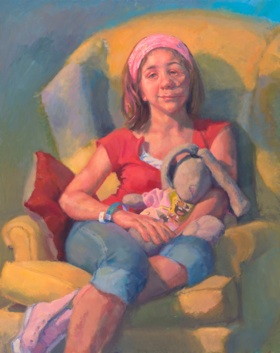Art Meets Medicine: For CHOP Patients, Portraits Are Treatment

When Philly portrait artist and caricaturist Debbie Schafer sat down with two new subjects back in 2008, she had little idea how close she would grow to the young people whose faces she sketched. It wasn’t going to be a quick job; the portraits would take two years to complete. But for her young subjects, the process was just as important as the finished product.
The faces in the portraits belonged to Emily and Kyle, two participants in Children’s Hospital’s Face to Face Portrait Project. A collaboration between CHOP’s craniofacial program and Philadelphia’s Studio Incamminati, the Face to Face exhibit seeks to increase the positive self-image of children and adolescents with craniofacial problems through the art of portrait painting.
“It’s very gratifying to create something that makes other people feel good, that is giving something to other people,” says Schafer, an alumnus of Studio Incamminati whose work has also involved sketching chemo patients.
In the first part of the ongoing project, eight patients were paired with four different artists who captured their subjects over a two-year period. The ages ranged from seven to 25, and the patients were at varying stages in their reconstructive surgeries. Those portraits were revealed last October and are now on display at CHOP’s Colket Translational Research Building.
“It’s rare that patients with facial disfigurements are the subject of art,” says Dr. Canice Crerand, psychologist in the hospital’s division of plastic and reconstructive surgery. “Most often we think of portraits as being reserved for individuals of great beauty or status.”
Dr. Crerand is one in a team of psychologists and surgeons that includes Dr. Linton Whitaker, founder of the hospital’s craniofacial program; Dr. Scott Bartlett, director of the program; and Dr. David Sarwer, associate professor of psychology at University of Pennsylvania School of Medicine. The artists, along with Schafer, are Stephen Early, Robin Dawn Frey and Kerry Dunn.
Work on the project began in 2007 after those involved saw a similar exhibit called Saving Faces by UK artist Mark Gilbert. Face to Face is the first of its kind in the United States.
When Kyle, 15, began meeting with Schafer, he was a bit shy and didn’t want his facial deformity to be highlighted in the portrait. Over the two years they worked together, Schafer watched as Kyle grew increasingly outgoing. The portrait shows the teenager lounging in a favorite hoodie.
“He is listening to an iPod, but one of the ear buds is just hanging because he only has one ear, and music is his life,” Schafer said.
Emily, 13, who suffers from neurofibromatosis and has had a dozen surgeries since the age of two, was drawn with a favorite stuffed animal bunny that never leaves her side. The subjects were allowed input on how they wanted to be captured in an effort to let individual personality, rather than the facial deformity, be the highlight of the portrait.
“Kyle really is a deep thinker, he really wants to save the world,” Schafer says. “And for Emily, I wanted to make her like a princess on the throne. The sparkly pink scarf—I wanted it to be her crown.”
Dr. Crerand interviewed each participant before and after the portraits were completed. There were also questionnaires to gauge each patient’s response to the project.
“By and large it was an overwhelmingly positive experience for all participants,” Dr. Crerand says. “Very often when you have a different appearance, that becomes what people notice first. This project enabled the kids to share with other people that they are more than their appearance. They are athletes, scholars, artists, Phillies fans …”
And there’s the project’s other goal: If the participants have more self-courage, it becomes easier for them to project that to others and help build awareness about craniofacial disfigurement, which is one of the most common birth defects and can also be caused by an injury or by disease.
So what’s up next? This past June the team put together a day of painting. Kids in the craniofacial program were able to meet with artists and learn how to draw a portrait. Another is planned for the fall. Face to Face recently received more funding from the women’s committee at CHOP, which will most likely go towards enrolling new patients in the portrait project. The eight existing portraits will also be moved this winter to CHOP’s Wood Center, home to plastic and reconstructive surgery. There, new patients can be inspired by the images the moment they walk through the door.
Ultimately, Crerand would love to see artists become a permanent part of the craniofacial program’s multi-disciplinary treatment team. But while the project’s future is still a bit uncertain, there are eight children and young adults that can attest to the benefit of a little art therapy.


